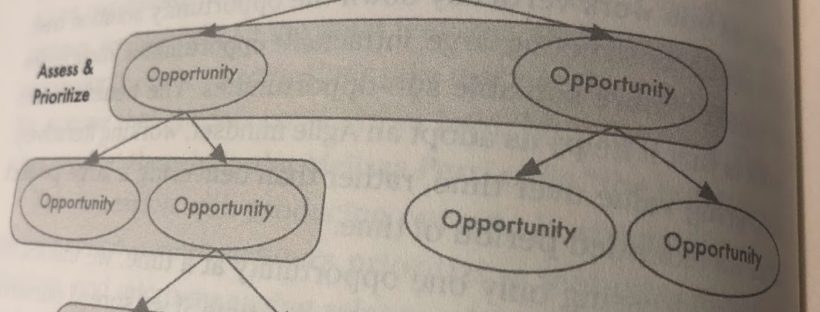★★★✬☆
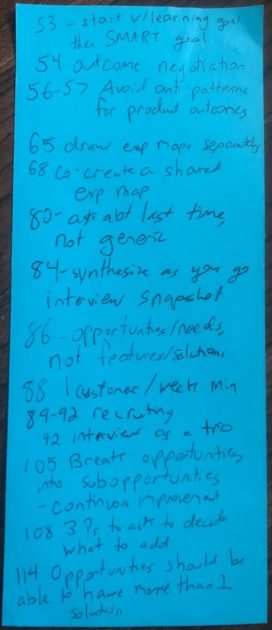
Continuous Discovery is a how-to book, with a series of clear instructions on how to do discovery, definition, ideation, and assumption / value testing. It also explains the why behind each step.
Personally, I’m used to the model that looks something like Discover > Define > Design (& iterate) > Develop > Deliver > Measure (& iterate). I was expecting 100% of this book to fall into the Discover category, and was surprised when it went beyond that.
While Teresa does emphasize at a few points that her methods are meant to help develop the right mindset, rather than a be-all end-all “right” methodology, the book still ends up being mostly an instructional book. And since it covers a lot of ground, the book covers one methodology at each step.
So if you’re looking to go from goal setting all the way through assumption testing with a step-by-step instruction book, this book is for you. However, if you’re looking for a comprehensive overview of different discovery methodologies and ways to document discovery findings, look elsewhere.
The book does have a lot of practical tips that I plan to bring back to work.
Chapters 5, 6, and 7 were the most valuable chapters for me.
Chapter 5, Continuous Interviewing
Page 80: Don’t let an interviewee tell you a generic “how they usually do things” story. Ask them about the last time. Be specific.
Page 80: Change the scope of the question based on your goals. If you’re looking for new opportunities, go broader; if you’re optimizing something that exists, go narrow.
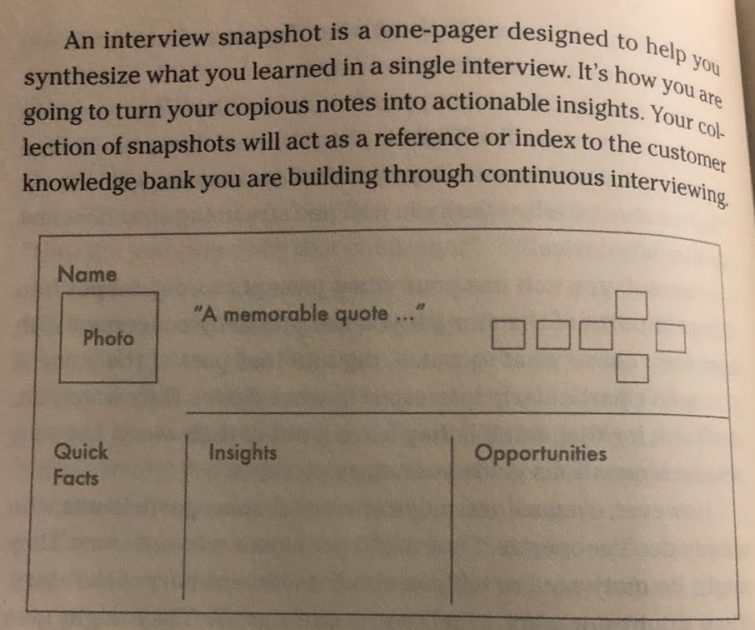
Page 84: Synthesize as you go by creating interview snapshots. This will help you remember specific stories, opportunities, and insights that you heard. (see image)
Page 86: Dig for opportunities and needs, not features and solutions. If someone suggests a feature they want, make sure you understand why, and capture the why.
Page 89-91: includes ideas to help automate recruiting, including:
- Add a question into your product/service asking if they’re willing to talk to you (with a link to scheduling software)
- Ask customer-facing colleagues, such as those in sales and customer support, to ask for interest in an interview based on defined triggers (i.e. cancellation)
- Create a customer advisory board, with a core group of customers you regularly interview (though you risk designing just for these customers, so make sure to use another method as well)
Page 92: Interview as a trio (product manager, product designer, product engineer); each of you may interpret the information differently
Chapter 6, Mapping the Opportunity Space
Teresa introduces her Opportunity Solution Tree concept earlier in the book; here’s an example framework from her site:
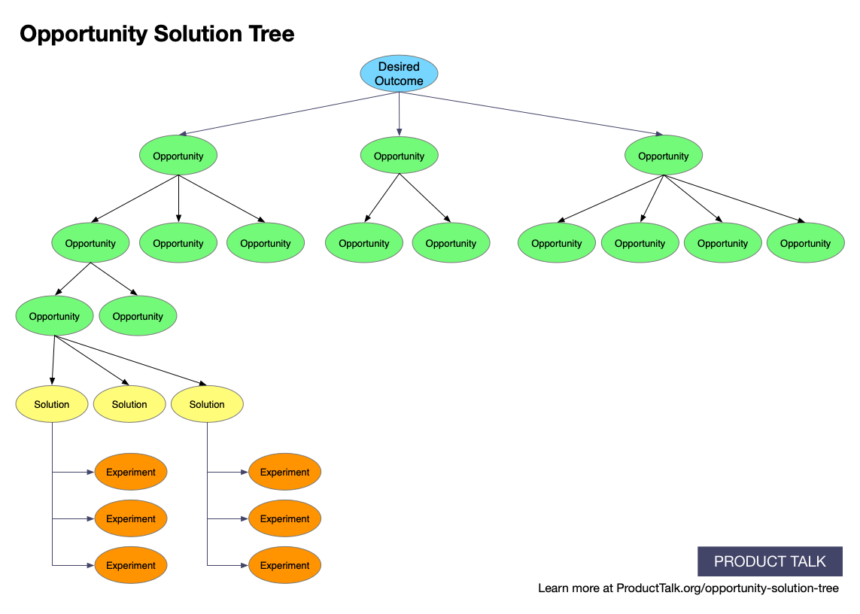
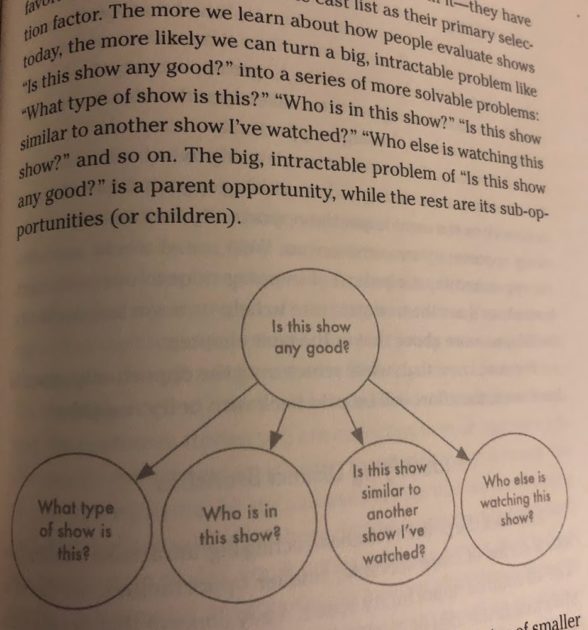
Page 105: Break opportunities into sub-opportunities; this helps make large problems more manageable, and lets us deliver value over time, a key tenet of Agile. (see image)
Page 108: When thinking about what opportunities to add to your tree, ask the following three questions:
- “Is this opportunity framed as a customer need, pain point, or desire and not a solution?
- Is this opportunity unique to this customer, or have we seen it more than one interview?
- If we address this opportunity, will it drive our desired outcome?”
Page 114: Opportunities should be specific; “this is hard to use” is not a good opportunity.
Page 114: Opportunities should be able to have more than one solution; if there’s not, you may have a solution disguised as an opportunity.
Page 115: Strong feelings often indicate an opportunity, but are not themselves an opportunity
I’ve found Teresa’s Opportunity Solution tree to be a useful framework when talking about ideas with my team and stakeholders.
Chapter 7, Prioritizing Opportunities, Not Solutions
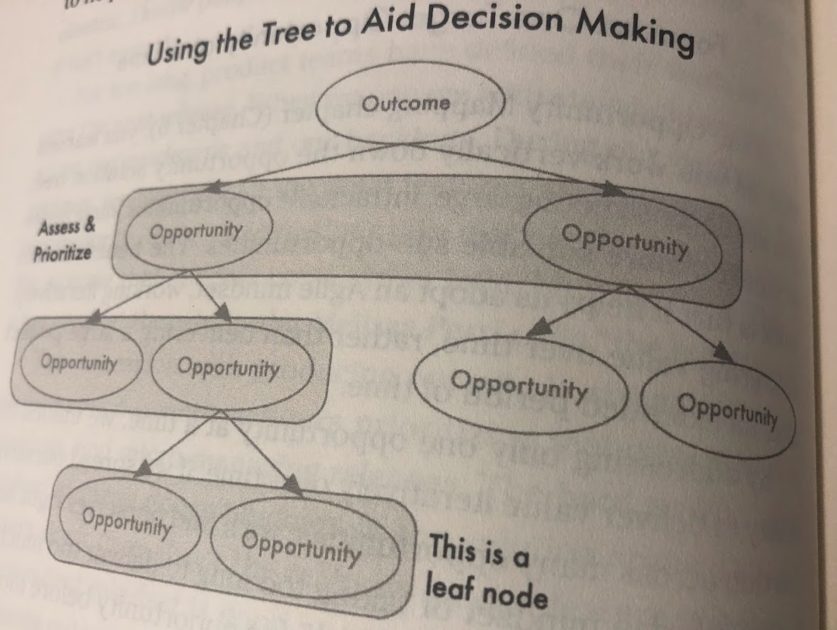
Page 120: You can move through the tree, assessing top-level opportunities, and working your way down.
Teresa suggests that when comparing opportunities, don’t think about “should we do this or not” for each one; rather, focus on comparing the different opportunities to each other.
Once you decide on an opportunity, you can start moving down the tree, assessing the options at each step. (see image)
Here are the criteria that Teresa suggests considering:
- Page 121, Opportunity sizing
- How many customers are impacted? How often are customers impacted?
- This doesn’t have to be precise; rather, it’s about comparing the opportunities to see which are the most impactful
- Page 122, Market factors
- How does addressing each opportunity impact our position in the market?
- This involves looking at external trends that might impact our choices.
- Page 122/123, Company factors
- What is the strategic impact of each opportunity for our company/business group/team?
- Opportunities should be selected that align with the company mission, vision, values, and goals
- Page 123, Customer factors
- How important is the opportunity to our customers?
- How satisfied are they with the existing solutions?
- Prioritize opportunities that are important to customers where they’re not happy with the current solution.
“Embrace the Messiness”
Page 124: Teresa recommends NOT trying to score each opportunity based on different factors and then stack-rank your opportunities. This should be a data-informed subjective opinion.
Earlier in the book, Teresa points out that we are dealing with ill-structured problems in the product world, and we shouldn’t try to treat them as if they were structured problems.
From my personal experience, I would mostly agree; I’ve found more value in impact/effort graphs, or satisfaction/importance graphs, versus trying a more RICE-like quantitative analysis (though as this article says, the results of a RICE analysis shouldn’t be treated like hard-and-fast rules).
“Two-way Door Decisions”
Page 125: A two-way door is a door you can walk through, and back out again. Choices in opportunity spaces are two-way doors; you can always re-assess as you go along and decide another opportunity is better to explore if one isn’t working out the way you’d hoped.
Wrap Up
Overall, a solid book with great ideas and useful examples. Narrower in terms of what I was hoping for within Discovery, but broader in terms of coverage of overall product process.
Did you read the book? Was this review helpful? I’d love to hear what you think.
